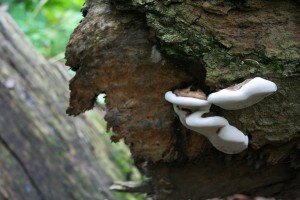Artist's Conk: Canvas of the Forest
Artist’s conk (Ganoderma applanatum) is a humble but fascinating fungus. It is ubiquitous not only in the Northeast, but in the majority of American and Canadian forests and suburbs. Here is a perennial species that clearly has an effective survival strategy, and can live well over a decade. If you cut a specimen in half, the number of layers reveals the age, like tree rings.
The artist's conk is a polypore, meaning it has pores instead of gills or teeth to release its spores. Polypores can be distinguished from other pored mushrooms, like the boletes, by their typically woody, shelf-like form, projecting straight out of tree trunks or logs. There are no poisonous polypores in the Northeast, but most are inedible due to their woody, rubbery, or fibrous textures.
With that said, some of my favorite fungi are polypores, such as maitake (Grifola frondosa), a superb and versatile cooking as well as medicinal mushroom, and reishi (Ganoderma tsugae and its close relative Ganoderma lucidum), a varnished pharmacy of the forest. In China reishi is called Lingzhi, and is considered a panacea only perhaps matched by ginseng in its adaptogenic properties.
Unlike the slightly fleshier reishi, the artist’s conk is woody through and through. While the artist’s conk is similar to the reishi in shape and size, its color palate is decidedly more subdued. Its cap surface is shades of brown and gray with a white, slightly softer growing tip on younger specimens. The pore surface on the underside of the cap is solid white, staining brown.
You can make intricate drawings on this surface with any sharp-pointed object such as a stick or the tip of a dull pencil. This makes a great art project for kids, that grown-ups are bound to get equally excited about! Make sure to carve them soon after picking for the boldest line, and be aware that the pore surface stains easily. After carving, you can simply let them dry out on their own with the pores facing up. Some artists choose to apply a finish, but the specimen will preserve itself for years either way.
Young Artist's Conk - Can you see the face in the wood?
As a perennial fungus, artist’s conks are one of the only mushrooms that can be found in all four seasons in the Northeast. In the winter you cannot etch on the pore surface, but you can still paint on it. Being in a drought mentality, the artist’s conk has been on my mind a lot recently. I see large, fresh specimens almost every time I go into the woods, at a time when few other mushrooms are fruiting. They can tolerate almost any habitat where there are dead and dying hardwoods, but have a particular affinity for lowlands. Their rich fungal aroma makes me long for porcini and maitake, but unfortunately even the youngest specimens are bitter and too woody to eat. Instead, the artist’s conk can be made into a medicinal tea or tincture, which mycologist Paul Stamets claims has strong antimicrobial and immune enhancing properties.
The only thing one might confuse the artist’s conk for is the red-belted polypore, distinguished by its red stripe near the growing tip. Like the artist’s conk, the red-belted polypore is innocuous and woody. Undoubtedly, the artist’s conk is a fixture of the world’s forests, and a very rewarding and safe mushroom to learn how to identify. If only it tasted good!


